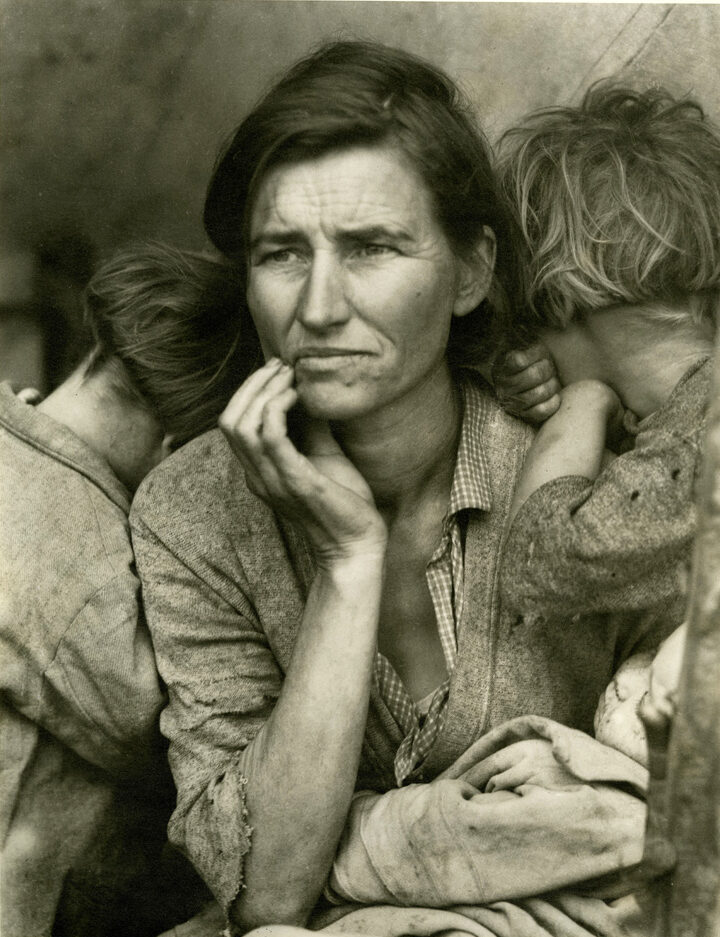California Stories

English Label
Dorothea Lange, United States, 1895-1965
Migrant Mother, Nipomo, California, 1936 (printed c. 1960s)
Gelatin silver print
Dorothea Lange’s photograph of a destitute migrant worker and her three children is one of the iconic images of the Great Depression. The third child, a baby nestled in the mother’s arms, suggests the aura of a desperate Madonna and Child. The other children are facing away, allowing us to focus on the troubled face of the mother. She was 36 years old.
“Dorothea Lange took this photograph in 1936, while employed by the U.S. government’s Farm Security Administration (FSA) program, formed during the Great Depression to raise awareness of and provide aid to impoverished farmers. In Nipomo, California, Lange came across Florence Owens Thompson and her children in a camp filled with field workers whose livelihoods were devastated by the failure of the pea crops. Recalling her encounter with Thompson years later, she said, ‘I saw and approached the hungry and desperate mother, as if drawn by a magnet. I do not remember how I explained my presence or my camera to her, but I do remember she asked me no questions. I made five exposures working closer and closer from the same direction.’ One photograph from that shoot, now known as Migrant Mother, was widely circulated to magazines and newspapers and became a symbol of the plight of migrant farm workers during the Great Depression.
As Lange described Thompson’s situation, ‘She and her children had been living on frozen vegetables from the field and wild birds the children caught. The pea crop had frozen; there was no work. Yet they could not move on, for she had just sold the tires from the car to buy food.’ However, Thompson later contested Lange’s account. When a reporter interviewed her in the 1970s, she insisted that she and Lange did not speak to each other, nor did she sell the tires off her car. Thompson said that Lange had either confused her for another farmer or embellished what she had understood of her situation in order to make a better story.” – Museum of Modern Art, New York
Spanish Label
Dorothea Lange, Estados Unidos, 1895-1965
Migrant Mother, Nipomo, California [Madre inmigrante, Nipomo, California], 1936 (impreso c. 1960)
Impreso en gelatina de plata
La fotografía de Dorothea Lange de una trabajadora inmigrante indigente y sus tres niños es una de las imágenes más icónicas de la Gran Depresión. El tercer niño, un bebé anidado en los brazos de la madre, sugiere el aura de una desesperada Madona con Niño. Los otros niños miran hacia otro lado, permitiéndonos enfocarnos en el rostro preocupado de la madre. La madre tenía 36 años de edad.
“Dorothea Lange tomó esta fotografía en 1936, mientras trabajaba para el programa Farm Security Administration [Administración de Seguridad de Granjas] (FSA) del gobierno de los Estados Unidos, formado durante la Gran Depresión para crear conciencia de y proporcionar ayuda a los empobrecidos granjeros. En Nipomo, California, Lange se topó con Florence Owens Thompson y sus niños en un campo lleno de trabajadores agrícolas cuya subsistencia se vio devastada por el fracaso de los cultivos de las arvejas. Recordando su encuentro con Thompson años más tarde, dijo, ‘Vi y me acerqué a la hambrienta y desesperada madre, como si fuera atraída por un imán. No recuerdo cómo le expliqué mi presencia o mi cámara, pero sí recuerdo que no me hizo ninguna pregunta. Hice cinco exposiciones trabajando cada vez más cerca desde la misma dirección’. Una fotografía de esa sesión, ahora conocida como Migrant Mother [La madre migrante], circuló ampliamente en revistas y periódicos y se convirtió en un símbolo de la difícil situación de los trabajadores agrícolas inmigrantes durante la Gran Depresión.
Mientras Lange describía las situación de Thompson, ‘Ella y sus hijos habían estado viviendo de vegetales del campo congelados y pájaros salvajes que atrapaban los niños. La cosecha de arvejas se había congelado; no había trabajo. Sin embargo, no se podían ir, porque había vendido las llantas del carro para comprar comida’. Sin embargo, más tarde Thompson disputó el relato de Lange. Cuando un reportero la entrevistó en los 1970, ella insistió en que ella y Lange no se hablaron, ni que ella hubiera vendido las llantas de su carro. Thompson dijo que Lange la había confundido por otra campesina o adornado lo que entendió de su situación para poder hacer una mejor historia”. – Museum of Modern Art [Museo de Arte Moderno], Nueva York

